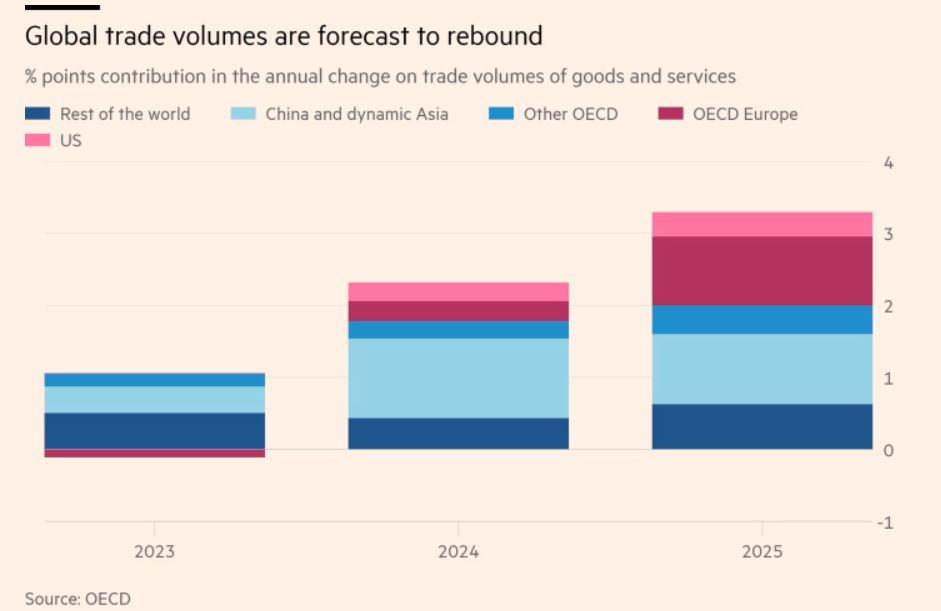The OECD, IMF, and WTO warned, however, that regional conflicts, geopolitical tensions, and economic policy uncertainty pose significant risks to the outlook and that "governments should now focus on national security, self-sufficiency, and support for domestic businesses."
"After last year's contraction, global merchandise trade is expected to experience a strong recovery in 2024."
On May 7, the Financial Times reported this, adding that several international agencies would make predictions that "global trade growth will more than double this year after experiencing rising prices, soaring interest rates and low demand in 2023."
The OECD's chief economist (Clare Lombardelli), on the other hand, stressed that China and East Asia will become the main driving force behind global trade.
OECD forecasts for growth in global trade in goods and services: China and East Asia have the highest contribution in 2024
The agency predicts that global trade in goods and services will grow by 2.3 percent in 2024 and expand further to 3.3 percent next year. This compares with 1 percent in 2023.
According to the latest Global Trade Prospects and Statistics report published by the World Trade Organization (WTO), the volume of global trade in goods decreased by 1.2 percent in 2023, but will grow by 2.6 percent in 2024 and 3.3 percent in 2025 due to the continued impact of high energy prices and inflation.
The International Monetary Fund (IMF), in the latest edition of its World Economic Outlook report, also predicted that the volume of global trade will grow at a rate of 3 percent by 2024.
According to the report, Lombardelli said the growth in global trade is largely due to a "cyclical recovery," in which trade grows in tandem with overall economic growth. He stressed that China and East Asia are expected to be the main drivers of trade activity.
"We have stronger numbers for trade this year and next, and we are seeing quite positive developments on the trade front." Lombardelli added.
Indeed, the impact of the recovery in global trade was reflected in the data for the first quarter of this year: the Eurozone's overall economic growth rate rebounded 0.3 percent, the highest level since the third quarter of 2022.
Even the chief economist of the British economic research organization Capitol Macro (Capital Economics), Neil Shearing, admitted that "there are indeed signs of recovery in global trade." He analyzed that the impact of the "manufacturing recession" on 2023 trade activity is now "coming to an end."
He noted that Europe, which is most dependent on trade, is showing signs of a modest recovery, while southern European countries are benefiting from a recovery in tourism.
Spain was one of the beneficiaries, with data from Spain's National Institute of Statistics showing that external demand contributed 0.5 percentage points to the country's quarterly GDP growth, while domestic demand contributed 0.2 percentage points. Germany, Europe's largest economy, also said growth in net exports boosted economic growth in the first quarter.
Data released by the German National Statistical Office on the 7th showed that German exports grew faster than expected in March this year, up 0.9 percent from the previous month.
Among them, German exports to China grew by 3.7 percent to 8.3 billion euros (equivalent to about 64.5 billion yuan).
Compared with the previous month, Germany's imports also increased by 0.3 percent. Most of Germany's imports in March came from China, and the value of imports from China reached 13.7 billion euros (equivalent to about 106.4 billion yuan), up 14.3 percent from the previous month.
"We were expecting a recovery in eurozone foreign trade this year, although signs show that the recovery -- particularly on the export front -- has come sooner than we expected. " Salomon Fiedler, an economist at German bank Berenberg, told the Financial TimescSalomon Fiedler.
According to the World Trade Monitor published by the Netherlands Bureau for Economic Policy Analysis (CPB), world trade in goods returned to growth in February this year for the first time in a year. Driven by economic expansion in China and the United States, the growth rate of global goods trade rose to 1.2 percent in February, up from a 0.9 percent contraction in the previous month.
According to the World Trade Monitor published by the Netherlands Bureau for Economic Policy Analysis (CPB), world trade in goods returned to growth in February this year for the first time in a year. Driven by economic expansion in China and the United States, the growth rate of global goods trade rose to 1.2 percent in February, up from a 0.9 percent contraction in the previous month.
Despite the gradual recovery in global merchandise trade, the agency predicts that global trade growth will not be able to return to pre-epidemic levels by 2024, the report said. IMF data show that global trade in goods and services grew at an average annual rate of 4.2 percent between 2006 and 2015.
The OECD, IMF, and WTO warned, however, that regional conflicts, geopolitical tensions, and economic policy uncertainty pose significant risks to the outlook and that "governments should now focus on national security, self-sufficiency, and support for domestic businesses."
Hillin also noted that the U.S. election has added uncertainty to the global trade outlook for 2025. Former U.S. President Donald Trump has previously stated that he would impose a 10 percent tariff on all goods imported into the United States if he is re-elected.


コメント